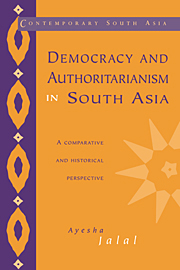Book contents
- Frontmatter
- Contents
- List of maps
- Preface
- Introduction
- 1 The colonial legacy in India and Pakistan
- 2 State formation and political processes in India and Pakistan, 1947 to c.1971
- 3 The ‘populist’ era and its aftermath in India, Pakistan and Bangladesh, 1971 to c.1993
- 4 The state and political economy, 1947 to c.1993
- 5 Central power and regional dissidence
- 6 Societies, cultures and ideologies: hybrids in contrived monoliths
- 7 Conclusion
- Bibliographical essay
- Index
3 - The ‘populist’ era and its aftermath in India, Pakistan and Bangladesh, 1971 to c.1993
Published online by Cambridge University Press: 26 October 2009
- Frontmatter
- Contents
- List of maps
- Preface
- Introduction
- 1 The colonial legacy in India and Pakistan
- 2 State formation and political processes in India and Pakistan, 1947 to c.1971
- 3 The ‘populist’ era and its aftermath in India, Pakistan and Bangladesh, 1971 to c.1993
- 4 The state and political economy, 1947 to c.1993
- 5 Central power and regional dissidence
- 6 Societies, cultures and ideologies: hybrids in contrived monoliths
- 7 Conclusion
- Bibliographical essay
- Index
Summary
The 1970s witnessed the crystallization of significant changes in the statesociety dialectic in South Asia. During the 1960s state interventions in the economy had contributed to important alterations in social structures and in the process broadened the arena of mass politics. In the absence of any perceptible movement towards the strengthening of equal citizenship rights for the many who remained outside the charmed circle of a small elite, largely unorganized resistance to established structures of dominance assumed new levels of potency. The expansion and radicalization of the social bases of politics posed challenges to oligarchical democracy and military authoritarianism alike. These were sought to be met by comparable experiments in what widely came to be termed ‘populist politics’ during the late sixties and the seventies.
Populism by its very nature is an elusive concept. Open to varied interpretations, populist politics in the South Asian subcontinent have escaped the exactitudes of a searching or rigorous historical analysis. To the extent that populism has been defined at all the emphasis lies on the personal aspects of the phenomenon. Yet a focus on the role of charismatic leaders has produced a somewhat shadowy, if not distorted, view of the populist drama. The appeal of populism lay in its claim to give voice to the frustrations of the dispossessed and downtrodden and in its declared aim to dent the existing structures of domination and privilege. It was really more a matter of temperament than ideology.
- Type
- Chapter
- Information
- Democracy and Authoritarianism in South AsiaA Comparative and Historical Perspective, pp. 66 - 121Publisher: Cambridge University PressPrint publication year: 1995



